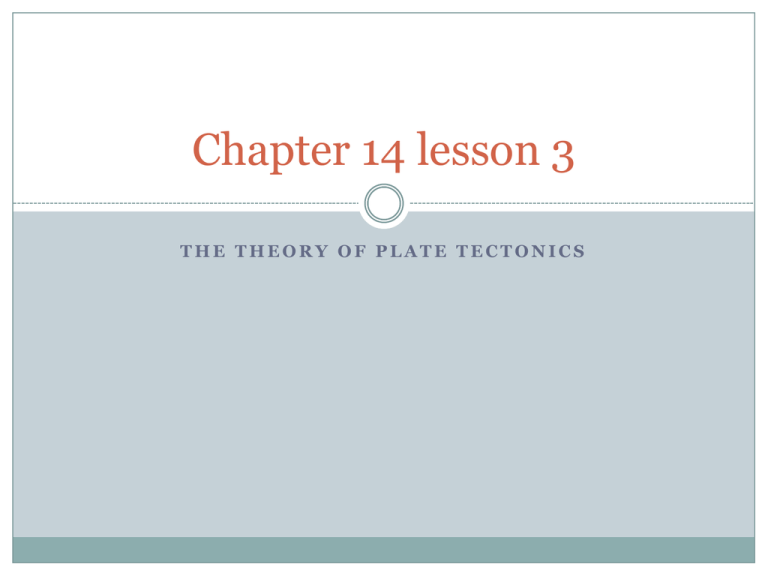Chapter 14 lesson 3
advertisement

Chapter 14 lesson 3 THE THEORY OF PLATE TECTONICS The Plate Tectonic Theory So we learned that new crust forms at the mid ocean ridges, but what happens to the older oceanic crust? Plate tectonics states that Earth’s surfaces is made of a series of rigid slabs of rock or plates that move with respect to each other Tectonic plates 17 total plates 8 major plates and 9 smaller Largest plate- the Pacific plate Lithosphere Outermost layer of Earth Consists of the crust and the solid, upper mantle Asthenosphere Directly below the lithosphere Very hot part of the mantle Solid but behaves like a liquid plastic material that flows Plate boundaries 3 types Divergent Convergent Transform Divergent Two plates are separating Can occur at a mid ocean ridge Oceanic and Oceanic plate Can also occur in the middle of a continent Continental and Continental plate Rift Valley like the Eastern African Rift Valley Convergent When two plates come together or collide The denser plate sinks below the less dense in a process called subduction. Continental and Continental Neither plate sinks below the other because the plates are of the same density Mountains are formed like the Himalayas Oceanic and Continental Oceanic plate is dense compared to a continental plate Oceanic plate subducts or sinks below the continental plate Deep ocean trench and line of volcanoes occur Transform Two plates slide past each other As they move, it is common for the plates to get “stuck” Stress builds up and the rocks break This leads to earthquakes and fault lines What causes the plates to move Convection Currents- the circulation of material caused by differences in temperature and density. Convection in the mantle- hot mantle rises toward the crust, it cools, and sinks back down only to be heated again. Forces causing plate motion Basal Drag- convection currents in the mantle act like a conveyor belt in the lithosphere Ridge Push- Rising mantle material at mid-ocean ridges creates the potential for the plates to move away from the ridge. Slab pull- the denser plate is called a slab when it collides with a less dense plate. As the slab sinks it pulls on the rest of the plate with a force called a slab pull. Theory in Progress Still many unanswered questions Why is Earth only planet in solar system with plate tectonic activity? Why do earthquakes and volcanoes happen away from plate boundaries? What forces dominate plate motion because we can’t measure convection currents?








